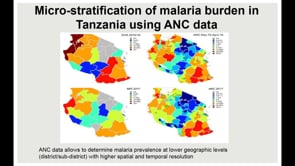ASTMH 2019, Chonge A. Kitojo: “The use of data from antenatal clinics as an adjunct for surveillance”
Collaborator(s): U.S. President’s Malaria Initiative (PMI), United States
Published: 22/11/2019
In collaboration with ASTMH, Image Audiovisuals, and session presenters, MESA brings you this webcast from the 68th ASTMH annual meeting in Maryland, November 2019
Title: “The use of data from antenatal clinics as an adjunct for surveillance”
Author: Chonge A. Kitojo, President’s Malaria Initiative, U.S. Agency for International Development, Dar es salaam, Tanzania, United Republic of
Session Information:
Symposium 55: Routine Data for Decision-Making: Driving Progress in Malaria Control
November 22, 2019, 8:00 AM – 8:20 AM, Maryland C (Ballroom Level)
Abstract:
The Global Technical Strategy for Malaria 2016–2030 (GTS) calls for reducing malaria cases and deaths by at least 40% by 2020, at least 75% by 2025 and at least 90% by 2030. At the current pace of progress, these targets are unlikely to be achieved. To catalyze progress, WHO recently launched the “High Burden, High Impact” strategy, calling on the eleven countries with highest burden to prioritize malaria. A key component of this new strategy is the use of data to optimize deployment of malaria control interventions for maximal impact, and an increased focus on obtaining quality surveillance data. Currently, the World Malaria Report uses models to estimate the number of malaria cases and deaths in the highest burden countries due to limitations in routine health information systems in these countries and because many countries face data quality challenges that limit data use. Improving data systems to enable the direct use of surveillance data is critical to making progress in malaria control scale-up and maintenance of high coverage, and represents Pillar 3 of the GTS. Routine data have the potential to provide more granular and timely information and, ultimately, to inform local and national decision-making. Yet, development and sharing of local, national and regional systems and protocols for data use to action is a critical gap in many malaria endemic countries. This session will highlight innovative initiatives across diverse settings to use routine data for decision-making. This includes presentations from two of the high burden, high impact countries: responding to apparent hotspots (Mozambique) and using data and data visualization through dashboards for stratification and targeting of interventions (Tanzania). Experiences from Zambia with data use for decision-making and lessons learned during adaptation of surveillance systems from elimination areas to higher burden areas will be presented as an example for other countries. In addition, an initiative from Tanzania that uses data collected from pregnant women attending antenatal care to monitor parasite prevalence will be presented, and the potential uses of these data for real-time surveillance and monitoring will be discussed. Finally, the chairs will engage the audience in a discussion of what it takes to implement these systems. This discussion will allow additional countries to share their experiences with the use of data for real-time decision-making to provide opportunities for peer learning.
THEMES: Modeling | Vulnerable Populations



